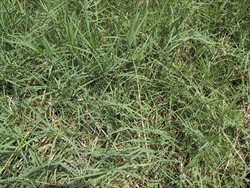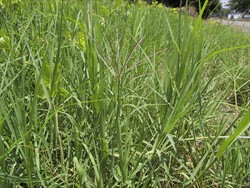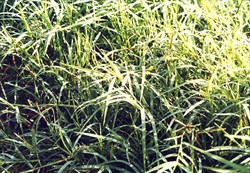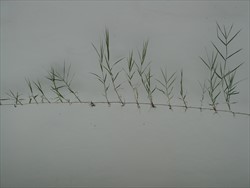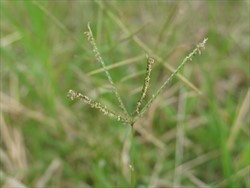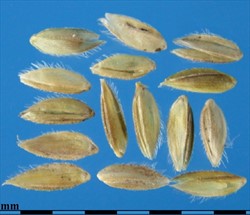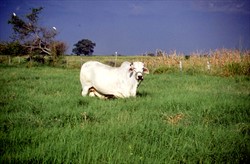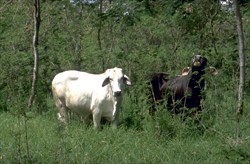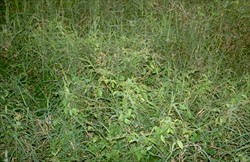Cynodon spp.
Tropical Forages
Cynodon aethiopicus Clayton & J.R. Harlan
Cynodon nlemfuensis Vanderyst
Cynodon plectostachyus (K. Schum.) Pilg.
Subordinate taxa:
Cynodon nlemfuensis Vanderyst var. nlemfuensis
Cynodon nlemfuensis Vanderyst var. robustus Clayton & J.R. Harlan
Note: Because of the general similarity in appearance between the various giant types of Cynodon, there has been considerable confusion over the years in the taxonomic affiliation of many specimens. It is suggested that all stargrasses identified as C. plectostachyus prior to 1970 were probably C. nlemfluensis. We have therefore chosen to treat these major species on a single Fact Sheet in an attempt to address the confusion. Epithets used in a particular publication should be viewed critically, since much of the available data actually relate to C. nlemfuensis or C. aethiopicus.
None listed in GRIN for any of the three species or the two varieties of C. nlemfuensis.
Family: Poaceae (alt. Gramineae) subfamily: Chloridoideae tribe: Cynodonteae.
Largely robust, sometimes fine, stoloniferous, deep-rooted group of perennials. Stolons often woody, and culms to 100 cm tall, and 1‒3 mm in diameter near the base. Leaf blades flat, linear lanceolate, green to purplish-red, pubescent to almost glabrous, 3‒30 cm long, 2‒7 mm wide, minutely scabrous; ligule a dense row of short hairs on a membranous rim 0.2‒0.3 mm long. Inflorescence a digitate or sub-digitate panicle, comprising 3‒20 spreading, spike-like racemes 3‒11 cm long, in 1‒7 whorls. Spikelets green, red or purple, 2‒3 mm long, with 1 caryopsis/spikelet. 2.2‒4 million spikelets/kg.
Species
C. aethiopicus: stolons appressed to ground, woody, coarse; culms 40‒100 cm tall, 2‒6 mm diameter. Leaf-blades conduplicate; 3–25 cm long; 3–7 mm wide; stiff; glaucous; leaf-blade surface scaberulous, glabrous or pilose, sparsely hairy. Racemes stiff, red or purple, 4‒8 cm long, 5‒17 borne in (1‒) 2‒5 whorls. Spikelets 2.5‒3 mm long; keel of lemma glabrous or with sparse hairs.
C. nlemfuensis: stolons appressed to ground, not woody; culms 30‒70 cm tall, 1‒3 mm diameter. Leaf-blades flat; 5–16 cm long; 2–6 mm wide; stiff, or firm; mid-green, or glaucous. Leaf-blade surface scaberulous, glabrous or pilose; sparsely hairy. Racemes slender or flexuous, green or pigmented, 4–7 (–10) cm long, 4–8 (–13) borne in 1 or 2 whorls. Spikelets 2‒3 mm long; glumes narrow lanceolate, the upper, 1/2‒3/4 of spikelet length; lemma silky pubescent to softly ciliate, palea glabrous.
var. nlemfuensis: culms to about 30 cm tall, 1‒1.5 mm diameter; leaf blades 2‒5 mm wide; racemes 3‒9, each 3.5‒7 cm long.
var. robustus: culms to about 70 cm tall, 2‒3 mm diameter; leaf blades 5‒6 mm wide; racemes 6‒13, each 6‒11 mm long. C. plectostachyus: stolons thick, arching; culms 30‒90 cm tall, 1‒4 mm diameter. Leaf-blades flat; 10–30 cm long; 4–7 mm wide; mid-green. Leaf-blade surface scabrous, rough on both sides, pilose, sparsely hairy, hairy on both sides. Racemes rigid, curling upward at maturity, 3‒7 cm long, 7‒20 borne in 2‒7 whorls. Spikelets 2.5‒3 mm long; small glumes (triangular scales), less than 1/3 (‒1/5) of spikelet length; lower 0.2‒0.3 mm, upper 0.4‒0.6 mm.
Similar species
Cynodon spp: stoloniferous only.
C. dactylon: stolons and rhizomes (robust forms bear superficial resemblance to this group of Cynodon species).
Common namesCommon names in general have not been applied consistently or uniformly applied to C. aethiopicus, C. nlemfuensis and C. plectostachyus. While "star grass" is commonly applied to these three stoloniferous species and "Bermuda grass" to the stoloniferous and rhizomatous C. dactylon, there are still instances of the names being used interchangeably.
C. aethiopicus
Afrikaans: reusekweekgras, stergras
English: African star grass, Bermudagrass, budgee grass, Ethiopian dog’s-tooth grass, giant quickgrass, giant star grass, Nakuru grass, star grass
Spanish: pasto estrella gigante
C. nlemfuensis
Africa: gifgras, Oos-Afrikaanse kweek, reuse kweekgras, stergras, sterkgras, vreemdevingergras (Afrikaans); urucaca (Burundi); chemorut, emurwa, kakodongo, lugowi, ruchwamba, rugoli (East Africa)
Asia: rumput bintang (Indonesia); kolatay (Tagalog), rukut-dukut (Visaya), galud-galud (Ilokano) (Philippines); ya-sata (Thailand)
English: African star grass, African Bermuda grass, giant star grass, robust star grass, Rhodesian star grass, star grass; Muguga star grass (Kenya)
Latin America: capim estrela, estrela-africana (Brazil); estrella Africana, estrella comun, estrella, estrella morada, grama estrella, pasto estrella, yerba estrella (Spanish)
Africa: gifgras, reusekweekgras, stergras, vreemdevingergras (Africaans)
English: feathery couch, giant quickgrass, giant star grass, star grass; Naivasha star grass (Kenya)
Latin America: capim estrela-africano, estrela da Africa, grama campista, grama de cidade, grama inglesa (Brazil); estrella, estrella Africana, bermuda mejorado, hawaiiano, pasto estrella (Spanish)
DistributionC. aethiopicus
Native:
Africa: Democratic Republic of Congo; Ethiopia; Kenya; Malawi; Mozambique; Rwanda; Sudan; Tanzania; Uganda; Zambia; Zimbabwe
Naturalized:
Northern America: U.S.A (Texas)
Australasia: Australia (Queensland)
C. nlemfuensis var. nlemfuensis
Native:
Africa: Angola; Democratic Republic of Congo; Ethiopia; Kenya; Malawi; Tanzania; Uganda; Zambia; Zimbabwe
Naturalized: elsewhere
C. nlemfuensis var. robustus
Native:
Africa: Burundi; Democratic Republic of Congo; Ethiopia; Kenya; Malawi; Rwanda; Sudan; Tanzania; Uganda; Zambia; Zimbabwe
C. plesctostachyus
Native:
Africa: Ethiopia; Kenya; Tanzania; Uganda
Naturalized: elsewhere
Uses/applicationsForage
Can be grazed or harvested for hay or silage. Larger types are suitable for cut-and-carry, although quality declines rapidly in bulky stands.
Environment
Useful live mulch and ground cover for weed control and soil conservation. In South Africa, C. plectostachyus is used for stabilization of mine dumps.
Other
C. aethiopicus and C. nlemfuensis have been shown to be resistant to root knot nematode (Meloidogyne spp.) and have the potential to reduce or eliminate nematode populations in preparation for establishing susceptible crops such as tomato (Solanum lycopersicum).
EcologyOccur in disturbed areas in grassland, cattle paddocks and road verges, and on moist alluvium.
Soil requirements
Grow on a wide range of soil types from sands to heavy clays, although best in moist, well-drained, lighter textured soils. C. nlemfuensis is adapted to soils with a pH between about 4.5 and 8, but ideally between about 5.5 and 7, and is not as salt tolerant as C. dactylon. C. plectostachyus is tolerant of alkaline soils and is always found in what appear to be alkaline areas in Kenya. It is adapted to soils with pH 6.5‒8.5, but gives best performance in the neutral to slightly alkaline range.
Moisture
All are very drought tolerant but produce little forage during periods of moisture stress. However, drought tolerance comparisons have been drawn. C. nlemfuensis grows in areas with an average annual rainfall between about 600 and 3,000 mm (commonly 800‒1,200 mm), and appears to be more drought tolerant than C. aethiopicus that originates from areas of similar rainfall. C. plectostachyus appears more drought-hardy than the others, growing down to 450 mm rainfall, but up to 4,000 mm (commonly 500‒1,500 mm). C. aethiopicus appears to be more moisture-demanding and less drought resistant than C. nlemfuensis. None tolerates prolonged flooding, but can withstand waterlogging for 2‒3 days.
Temperature
C. nlemfuensis occurs from about 15º N to 15º S, and from sea level to >2,300 m asl, representing a range in average annual temperature from about 20-27ºC. However, in Florida, USA, it is not recommended north of a line between Brooksville and Orlando. Although the average annual temperature in these cities is about 22 ºC, the very low winter temperatures beyond the line can cause winter kill. In Australia, var. nlemfuensis is naturalized in areas with average annual temperature down to 18 ºC, suggesting the limitation lies either with the variety, or the freeze factor that is experienced in the USA but not in Australia. C. aethiopicus extends over a similar native range to C. nlemfuensis, but C. plectostachyus appears limited to a more restricted range within the tropics than the others.
Light
All grow best in full sun or light shade, although some types, at least, seem adapted to moderate shade providing fertility is adequate.
Reproductive development
A more restricted flowering period than C. dactylon, apparently flowering in response to short days. C. nlemfuensis genotypes produce little or no seed, whereas, generally speaking, C. aethiopicus and C. plectostachyus produce reasonable amounts of seed.
Defoliation
All are tolerant of heavy grazing although the finer types appear more grazing tolerant than the more robust types. Under continuous heavy grazing or regular cutting in infertile soils, stands tends to succumb and the sward is opened to invasion by broadleaf weeds and C. dactylon. If well fertilized, they grow vigorously, producing the best combination of yield and quality when grazed or cut every 4‒5 weeks, which generally means maintaining a stubble height of 15‒25 cm, and allowing the sward to reach 30‒70 cm. More rapid rotation of grazing animals (say every 1 or 2 weeks), can lead to higher liveweight gains, providing overall stocking rates and adequate stubble levels are maintained.
Fire
Plants recover quickly after fire, and can even benefit through spittlebug and disease control by fire.
AgronomyGuidelines for establishment and management of sown forages.
Establishment
Due to minimal seed set in some types and the ease and reliability of vegetative establishment, these grasses are mostly propagated using either sprigs (above-ground stems) or stolons (runners) at a minimum of 1 t/ha on less than a 1 m grid. The area should be free of C. dactylon. Freshly harvested planting material is broadcast on clean cultivated soil and covered by discing 5‒10 cm deep and heavily rolled. With manual planting, stems are inserted into the soil to 75% of their length before compacting. When placed in a moist, firm seedbed, nodes sprout in 5‒10 days, and a solid stand can be achieved in 3 months after planting under good conditions. Sprigs and newly established plants are susceptible to drought and should be kept moist.
Fertilizer
For optimum establishment and early growth, they should have an initial application of 40 kg/ha each of N, P, and K, with a follow-up application of 35‒50 kg/ha N about 30 days later. Under normal management, little fertilizer is required for survival, but stands are unproductive. DM yields can be improved markedly by applications of nitrogen, with at least 10 kg/ha N applied monthly. In hay production or cut-and-carry systems, where plant material and therefore nutrients are removed, 50‒100 kg/ha N should be applied 4‒6 weeks before each cutting, and levels of other nutrients in the soil maintained or closely monitored.
Compatibility (with other species)
These are very vigorous grasses that, unmanaged, can overgrow associated legumes. However, they are mostly not very shade tolerant, and can be shaded out by taller grasses and trees.
Companion species
Grasses: Usually not planted with other grasses.
Legumes: Arachis pintoi, Centrosema molle, Desmodium uncinatum, Listia bainesii, Stylosanthes guianensis, Trifolium repens.Pests and diseases
None of these grasses is greatly affected by diseases, particularly if managed to remain young and leafy. The major diseases are rust, caused by Puccinia graminis and P. cynodonis, and Helminthosporium leaf-spot. There are also records of leaf blight disease caused by Rhizoctonia solani during the rainy season, black choke on inflorescences and leaves caused by Ephelis sp., a smut caused by Ustilago cynodontis, and another spikelet disease caused by a Fusarium sp.
Nematodes isolated from these grasses include the stubby root (Trichodorus), spiral (Helicotylenchus), stealth (Hemicycliophora), ring (Hemicriconemoides), stunt (Tylenchorhynchus), awl (Dolichodorus), and lance (Hoplalaimus) nematodes. Farmers need to be aware that build up of nematodes under stargrass can lead to severe consequences in subsequent nematode-susceptible vegetable and ornamental crops.
Fall armyworm (Spodoptera frugiperda) and spittlebug (Prosapia bicinata) are the major insect pests, along with strip grass looper caterpillar (Mocis latipes).Ability to spread
Some types produce reasonable amounts of seed and have vigorous seedlings, thus having considerable potential for spread by seed. However, those that produce little or no seed can still spread vegetatively at around 2 cm/day over bare soil in the growing season.
Weed potential
All have fibrous, resilient stolons that survive ploughing, stands actually being improved by cultivation. These grasses can therefore become weeds in cropping systems, although they are not as serious as C. dactylon.
Feeding valueNutritive value
Forage quality when harvested or grazed every 4‒5 weeks is about the same for most star grasses. Under good management with about a 4-week rotation, CP values are mostly of the order of 11‒16% and IVOMD, 55‒60%. Quality can be improved to 18% CP and 68% IVOMD by reducing the rest period to 2 weeks, but persistence may suffer in some environments if the rest period is less than 3 weeks over an extended period. Alternatively, if the rest period is increased to 7 weeks or more, CP levels can fall to 7‒8% and IVOMD to 42‒53%. Stargrass is most nutritious when grazed every 4‒5 weeks. Phosphorus levels in the DM of between 0.1 and 0.4% and calcium from 0.2 to 0.5% have been recorded. These are generally similar in 3.5-week regrowth of Digitaria eriantha, Cynodon dactylon and C. nlemfuensis. Digestibility of top growth killed by frost declines by 5‒6 percentage units after 1 week, and 15‒18 percentage unit after 4 weeks.
Palatability/acceptability
Although mostly very palatable when young, acceptability to cattle declines rapidly beyond about 5-week regrowth. C. nlemfuensis is often preferred by cattle to the more robust C. aethiopicus. Some varieties are not readily eaten at any stage.
Toxicity
Both C. aethiopicus and C. nlemfuensis have the potential to produce high levels of prussic acid (HCN) any time during the growing season, particularly when heavily fertilized with nitrogen. Levels of up to 150 ppm HCN have been measured in C. nlemfuensis and up to 250 ppm in C. aethiopicus. These decline after about 4 weeks. However, confirmed cases of prussic acid poisoning are not common. While reports of high levels of HCN in C. plectostachyus exist, these may well result from mistaken identification of the species in question, and actually refer to C. nlemfuensis .
Feedipedia link
Production potentialDry matter
Yields vary greatly with time of year, moisture availability, defoliation management, and nitrogen fertility. In the subtropics, C. aethiopicus, C. nlemfuensis and C. plectostachyus can produce monthly summer yields of the order of 1,000‒2,000 kg/ha, 1,600‒2,000 kg/ha, and about 1,300 kg/ha/month respectively, compared with 165‒500 kg/ha, 400‒1,000 kg/ha and 300‒1,100 kg/ha during the cool winter months. Annual dry matter yields vary from about 5 t/ha in low input systems to 10‒15 t/ha with good management, and up to 25 t/ha with irrigation and high N fertilization.
Animal production
Average liveweight gains of 700‒800 kg/ha from 225 kg steers grazing at a stocking rate of 8 beasts/ha can be achieved over a 200-day warm season from well-managed pastures. However, 1,000‒1,500 kg/ha LWG are also possible.
Genetics/breedingPloidy levels vary with the species:
C. aethiopicus 2n= 18, 36
C. nlemfuensis 2n = 18 (rarely 36)
C. plectostachyus 2n = 18
Although these grasses all appear similar, DNA comparison indicates strongest species similarities were between C. aethiopicus and C. arcuatus, C. plectostachyus and C. transvaalensis, and C. nlemfuensis and C. incompletus, and little variation within C. aethiopicus. Evidence suggests that some types, at least of C. aethiopicus, are apomictic, while C. nlemfuensis may be outcrossing. C. nlemfuensis var. nlemfuensis crosses with the diploid form of C. aethiopicus, and also the tetraploid C. dactylon var. dactylon. The forage cultivar, ‘Tifton 85’ bermudagrass was bred by crossing a tetraploid introduction of C. dactylon with ‘Tifton 68’, a tetraploid strain of C. nlemfuensis.
Seed productionSome types of C. aethiopicus and C. plectostachyus are capable of significant seed production, although experience in Florida suggests some genotypes of C. aethiopicus produce little or no seed there. Most workers agree that C. nlemfuensis prduces very low amounts of seed.
Herbicide effectsBroadleaf weeds can be controlled using a mixture of dicamba and 2,4-D. For harder-to-kill pasture weeds triclopyr may be effective. Cynodon spp. are generally fairly tolerant of glyphosate at normal rates, but appear susceptible to haloxyfop.
Strengths
- Rapid establishment from vegetative cuttings.
- Persistent when properly managed.
- Drought tolerant.
- Some types make good cool season growth with adequate moisture and fertility.
- Palatable and high quality forage when harvested or grazed regularly.
- Good LWG per animal and per hectare.
- Hay cures rapidly under favourable conditions.
Limitations
- No commercial seed available.
- Low productivity during dry periods.
- Top growth killed by frost.
- Requires higher fertility than Paspalum notatum, Hemarthria altissima and Digitaria eriantha (pangola).
- Forage quality drops rapidly after 5 weeks of regrowth and following heavy frost.
- Acceptability to cattle declines rapidly with time.
- Some types produce high HCN.
Selected referencesBogdan, A.V. (1977) Tropical Pasture and Fodder Plants. Longman Inc., New York, USA. p. 98–103.
de Wet, J.M.J. and Harlan, J.R. (1970) Biosystematics of Cynodon L.C. Rich. (Gramineae). Taxon 19:565–569. doi.org/10.2307/1218950
Hanna, W.W. (1992) Cynodon dactylon (L.) Pers. In: Mannetje, L.’t and Jones, R.M. (eds) Plant Resources of South-East Asia No. 4. Forages. Pudoc Scientific Publishers, Wageningen, the Netherlands. p. 100–102. edepot.wur.nl/327785
Harlan, J.R., de Wet, J.M.J. and Rawal, K.M. (1970) Geographic distribution of the species of Cynodon L.C. Rich (Gramineae). East African Agricultural and Forestry Journal 36:220–226. doi.org/10.1080/00128325.1970.11662465
Harlan, J.R., de Wet, J.M.J., Huffine, W.W. and Deakin J.R. (1970) A guide to the species of Cynodon (Gramineae). OSU Agricultural Experiment Station Bulletin B-673. Oklahoma State University (OSU), Stillwater, OK, USA. dc.library.okstate.edu/digital/collection/AgCoop/id/3320/
Hodges, E.M., Boyd, F.T., Dunavin, L.S., Kretschmer Jr., A.E., Mislevy, P. and Stanley Jr., R.L. (1975) McCaleb stargrass. Florida Agricultural Experiment Station Circular S-231. University of Florida, Gainesville, FL, USA.
Mislevy, P. (1989) Florona Stargrass. Florida Agricultural Experiment Station Circular S-362. University of Florida, Gainesville, FL, USA.
CultivarsC. aethiopicus
No. 2 Stargrass Released Zimbabwe. See 'Henderson/Rhodesian No. 2'
C. nlemfuensis
'Florico' (Puerto Rico PI 2341; PI 562690) Released in Florida, USA (1988). Originally from Kenya, evaluated in Puerto Rico. Leaves and leaf sheaths hairy. Differentiated from 'Ona' and 'McCaleb' by its hairiness and dark green-purplish colour. Adapted to soils that are saturated but not flooded for long periods of time. High nutritive value if managed correctly. Good carrying capacity and average daily gain, and higher IVOMD and better persistence than 'Ona'. Tends to average about 2‒3 percentage units higher IVOMD than 'Florona', 'Ona' or 'McCaleb' stargrass. Potential to produce high levels of HCN.
'Florona' (PI 562691) Released in Florida, USA (1988). Naturalized type of unknown origin. Leaves and leaf sheaths glabrous except for few hairs on upper surface of leaf. Adapted to soils that are saturated but not flooded for long periods of time. Forms a moderately open sod with clumps of erect stems giving a bunch effect. Higher yielding than 'Ona' and 'Florico' but slightly lower digestibility. Potential to produce high levels of HCN.
'Henderson/Rhodesian No. 2' (PI 617094) Released in Zimbabwe. Origin unknown. Sometimes listed as C. aethiopicus. Early elite variety, distributed to other countries including Malawi and USA.
'IB-8' ('Ibadan 8') Released in Southern Nigeria (1968). Originally from near Lake Manyara, Tanzania. Higher yielding but nearly 50% lower intake than 'IB-1', the local variety.
'McCaleb' (PI 224152) Released in Florida, USA (1975). Institutional collection from Johannesburg, South Africa. Adapted to soils that are saturated but not flooded for long periods of time. Establishes rapidly with high forage production under high fertilization. Standard for subsequent releases. Replaced by C. nlemfuensis varieties, which are more persistent.
'Muguga' Stargrass Released in Zimbabwe. Originating from Muguga Station, near Nairobi, Kenya.
'Ona' (PI 224566) Released in Florida, USA (1979). Institutional collection from Zimbabwe. Adapted to soils that are saturated but not flooded for long periods of time. Higher yielding during the cool season than Paspalum notatum or Digitaria eriantha (pangola). Good disease resistance and insect tolerance and an acceptable nutrient content. Potential to produce high levels of HCN. While some 'Ona' still exists, much has been replaced by 'Florona' and 'Florico'.
'Okeechobee' Released in Florida, USA. Origin unknown. A contaminant in stands of C. dactylon cv. Callie; more persistent than 'Callie'. Dry matter yields similar to 'Florona', but slightly lower CP levels and slightly higher IVOMD under similar management.
C. plectostachyus
None released to date.
Promising accessionsC. aethiopicus
IB-12 Selected in southern Nigeria.
C. plectostachyus
PI 341817 High yielding variety at Corozal Substation, Puerto Rico.
None reported for C. nlemfuensis.
